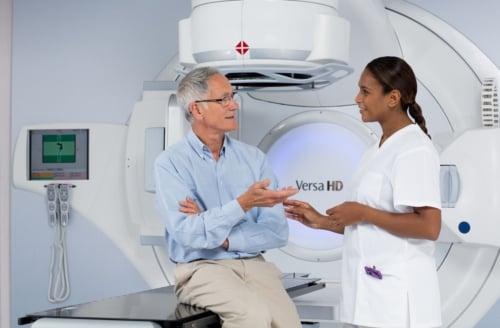
April 25, 2013 — The American Society for Radiation Oncology (ASTRO) has issued a new white paper, “Assuring Safety and Quality in Image Guided Delivery of Radiation Therapy,” that recommends best practices to improve the safety and effectiveness of image guided radiation therapy (IGRT), according to the manuscript published as an article in the online journal Practical Radiation Oncology (PRO).
The white paper recommends a set of 10 fundamental elements of IGRT safety in clinical programs and provides an additional list of recommended activities for the broader radiation oncology community to consider.
IGRT is the use of dedicated devices for fraction-by-fraction imaging and guidance of radiation treatment delivery that localizes the target and normal structures to ensure precise and accurate placement of the radiation. IGRT-enabled accuracy and precision allow for highly conformal dose distributions, higher dose prescriptions and shorter fractionation schedules for patients. This requires a strong link between IGRT practices and planning target volume (PTV) design of a patient’s treatment protocol, which is central to high quality, safe radiation therapy.
The manuscript recommends the four major categories for consideration in assuring safe, high-quality radiation therapy using IGRT technologies as
- Commissioning and continuing quality assurance (QA) of the systems
- Protocols for image acquisition and interpretation
- The link between image guidance practices and PTV margin
- Education, training and human resources.
The 10 foundational elements for safe and effective IGRT practices prescribed by the study are:
- Establish a multi-professional team responsible for IGRT activities
- Establish and monitor a program of daily, monthly and annual QA for all new or existing IGRT sub-systems
- Provide device- and process-specific training for all staff operating IGRT systems or responsible for IGRT delivery
- Perform end-to-end testing for all new IGRT procedures and document performance prior to clinical release
- Establish process-specific documentation and procedures for IGRT
- Clearly identify who is responsible for approval of IGRT correction decisions and the process whereby the decision is made and documented
- Establish and document site-specific planning procedures, specifically the procedure for defining PTV margins, and link these planning procedures to IGRT procedures
- Multi-professional peer review of PTV volumes, and peer-review of gross tumor volume (GTV) / clinical target volume(CTV) by radiation oncologists
- Verify proper creation and transfer of IGRT reference data (PTV, organs at risk (OARs), digitally reconstructed radiographs (DRRs), etc.) to IGRT system
- Establish a reporting mechanism for IGRT-related variances in the radiation treatment process.
For more information: www.astro.org, www.practicalradonc.org


 December 11, 2025
December 11, 2025 









